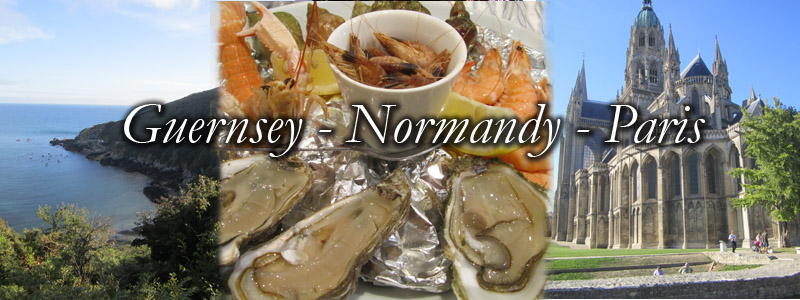 |
Guernsey Again (4th time in 5 years) and MoreWe were excited to be returning to Guernsey (4th time in 5 years.) Here's a link to an article written after the first trip and which explains a bit of our fascination with this tiny Channel Island. On Monday, August 26, we took Air Transat to Gatwick and stayed overnight in London, the reason for the stopover being to see Daniel Radcliffe (aka Harry Potter) on stage. (Tana had seen a review of the play and, being a Harry Potter fan, wanted to go.) London Arriving around noon, we caught The Gatwick Express to Victoria Station and checked into our hotel, the Airways Hotel which is near both the Victoria train Station and a GuernseyWednesday, Aug 28 We woke to sunshine and headed back to Gatwick for our Aurigny flight to From the airport, we caught the bus into town. After checking in to our familiar hotel. The St George's Hotel (on the Esplanade overlooking the old harbour) and chatting with Davina, who has managed it for many years and recently bought it, we strolled through town, ending the day at The Ship and Crown Restaurant where, while looking out over the Harbour and watching Castle Cornet light up, George ordered a Half Lobster dinner and enjoyed the first of his many great seafood meals of this trip. Thursday, Aug 29 The day started again with sunshine, a leisurely breakfast and a message from Roger Berry to meet that afternoon at his place in St. Martins. We spent the morning at the Island Archives searching through materials that had been compiled for us (grist for another article) and trying to trace the fief in which Bellieuse Farm (the house where George's grandfather was born) is located. One focus of this trip was to learn more about the farmhouse - and its history. Then it was off to St Martins on the #81 bus to meet Roger Berry at his home across from Bellieuse Farm. Roger is a previous owner and still owns part of the farm property. He's also an Island historian, previous president of Guernsey’s Board of Administration and Deputy of the States AND a priceless source of information - here's just a sampling: - After purchasing Bellieuse Farm in the 1970s, Roger set to restoring it. After removing plaster from some interior walls, he found Linenfold (or linen fold), a simple style of relief carving used to decorate wood panelling with a design imitating folded linen. It had become popular in the 13th and 14th centuries and Roger had considered getting it carbon-dated. Much of the Linenfold he'd discovered at the farmhouse was beyond salvaging but he did save what he could. He showed us, in the living room of his current home, a small wall that is covered with some of that salvaged Linenfold. And he graciously gave us a sample piece that he had wrapped up for us; we're now looking into having that piece carbon-dated. - When we asked about our difficulty tracing the history of the farmhouse, he explained Guernsey's feudal heritage and what it means that Bellieuse Farm is still part of a fiefdom– Fief de Blanchelande – which was first established in 1199 when the Duke of Normandy, then King John of England, transferred the land to the Abbey of Blanchelande in Normandy.
Witchcraft was rife in Guernsey from earliest times and persisted into the 1900’s. The courts were dealing with cases still in the 1930’s.The last case was against someone who had produced some magic powder to cure someone. (It was found to be just baking powder.) La Bellieuse also had some anti-witch symbols carved into oak panels by the front door so the families there were concerned with this threat. With our minds filled with information, we headed back to SPP, ending the day at the Village East Bistro where George washed down his magnificent platter of calamari, scallops and king prawns with an excellent wine. Friday, Aug 30 There was a cool mist in the morning that quickly burned off. After breakfast, we headed back to the Island Archive where the librarian had done some further searching and found some Bellieuse Farm sale documents from the early 1900s. After picking these up, we walked up to the Priaulx to search old newspapers for information about the death of Captain William (Guillaume) Peter Bartholomew Loney (WPBL), George's great, great, great grandfather, who supposedly died in 1845. Because we'd been unable to locate death records or a burial site for him and he was a "Captain," we'd been thinking he might have died at sea and were looking for any news of shipwrecks. When we found nothing, the staff explained to us how frequent death-at-sea was at that time and how likely it was that there would be no record. But they became curious too and, eager to help solve the mystery, they did a search of various burial records and discovered that he had, in fact, been buried in the Castel Church cemetery on May 9, 1842.
Once settled in, we went for a long walk along the path to the cliffs overlooking Moulin Huet Bay, heading back just as darkness set in, ready for a fabulous dinner - fish soup and fresh baked local crab for George.
Saturday Aug 31
We walked on through residential areas of Castel until we came to a bus stop and took off to Cobo Bay on the west coast for lunch, after which we explored briefly The Bridge; then returned to La Barbarie for another great dinner - George had the fish soup again - it was just too good!
Sun Sept 1 We had enjoyed our stay at La Barbarie not just because of the fish soup but also because it's a genuine country inn - elegant but comfortable, rural but civilized - a place we were sorry to leave and to which we will definitely return. After checking out, we took a taxi back into SPP to attend the service at Town Church. It's a lovely church and it's where George's great, great, great grandparents had been married in 1820. We've attended a service there on every trip to Guernsey - the first time we met the Dean and discovered he was from Canada and on G’s 3rd visit (with Ryan in 2012), George met and talked with a man who turned out to be Steve Foote's father. Steve, with whom we are now in contact, is a Guernsey genealogist/historian. He recently sent us an excellent article on the butcher's in Guernsey - of interest because George's great, great grandfather (who emigrated from Guernsey to Canada) was a licensed butcher. We walked out of the church into a warm, sunny day and wandered along the Esplanade looking at the antique/book/craft stalls that were set up for the day and had our first real Guernsey ice cream cone, before boarding the Condor Ferry for Saint-Malo, the walled port city in Brittany which we had visited from Jersey (for just an afternoon) a few years ago. Once notorious for piracy, Saint-Malo is now a major tourist destination. We spent the night there in a well-located, modern (very pleasant) hotel (Hotel du Louvre), did some exploring and some shopping and had Crepe Bretogne - actually a savoury version called a Gallette for dinner (a change from fish for George) at La Brigantine and went back to our hotel to do some prepatory reading on Normandy.
To Normandy
Monday, Sept 2 After a simple breakfast at a bakery, we picked up our rental car and drove in the direction of Normandy, making a stop at Mont Saint- After touring the town and the abbey, and, in the process, doing a lot of climbing, we had a light lunch and were on the road again, heading to Bayeux where we had booked a family run B&B Aggarthi for two nights. It wasn't elegant and, in fact, rather rustic but in a pleasant way. The room was fine and Tana loved the place largely because of the 2 dogs, 5 cats, 2 rabbits, and the numerous chickens who roamed freely in the completely enclosed (and safe) courtyard/garden. The rabbits, who were huge and litter-trained, often cuddled into bed with their owner at night along with at least one of the cats - usually the tabby - an especially friendly guy who happily shared his litter box with the rabbits. They were the pampered pets of the innkeeper, Myriam, who looked like she was right out of Les Miserables. (None of the animals, all being quite independent, agreed to pose with her.) After an initial exploration of the city, we had a pleasant dinner at a casual, very busy spot recommended by Myriam and settled in for the night. Tuesday Sept 3 We woke to a heavy fog that quickly burnt off and, after breakfast (with the tabby), spent the morning seeing the sites of Bayeau: - Bayeux is the home of the famous Bayeux Tapestry which depicts the events leading up to the Norman conquest of England by William, Duke of Normandy, culminating in the Battle of Hastings. The very large/long tapestry is kept (perfectly preserved) behind glass in a museum located conveniently (for us) very near our B & B. We were impressed by the workmanship and became more & more intrigued as we learned about the role it had played in relaying (and keeping alive) the history of that event. Taking a brief break from that topic of war, we drove to Port-en-Bessin-Huppain on the English Channel for a seafood lunch (at L'Ecailler Restaurant - an excellent spot on the harbour that Myriam had assured us used only fish caught that day.) Then, we drove west along the coastline to the 90-foot cliffs of Pointe du Hoc, part of Omaha Beach, (American sector). On the way back to Bayeux, we stopped at the German cemetery which contains the graves of 21,300 German soldiers. Along the road leading to it are planted 1200 maple trees, a living symbol of peace among nations. Until 1947, it had been an American cemetery but, after the remains were exhumed and shipped to the US, it became German; It's a solemn reminder that young men (most in their teens or Wednesday Sept 4 Up with the sun, we had an early breakfast, said good-bye to Myriam and the
A drive east along the coast through unattractive seaside resorts and the very popular but, to us, entirely unappealing, Deauville brought us
Thursday Sept 5 The day was warm and sunny so we started off with a croissant & coffee at one of the cafes along the beautiful harbour before heading off for a drive in Pays d’Auge, along the “Cider Route" - a drive along country roads sprinkled with appealing small, quiet Norman towns. When finally we stopped for lunch, it was already mid-afternoon and we could find only one restaurant still serving food. It turned out to be excellent. George had a very tasty ratatouille filled Galette. For Tana, this "lunch" consisted of a decadent array of gelato/sorbets. Since we rarely eat desserts, this was a chance to indulge. Yes, Tana did eat well on this trip too but, because her meals tended to be risotto, pasta, or omelettes, the focus is on the great seafood George was enjoying. Friday Sept 6 After enjoying (one more time) a coffee & croissant by the Harbour, we headed west towards Brittany to spend our last night in a town close to St. Malo as we had to return the car to the train station there the next morning & catch our train to Paris. Before bidding farewell to Normandy, we both wanted to visit Pegasus Bridge (which held some special fascination for us - perhaps because of the book we'd been reading that had made what happened there so real.) We had a lovely early lunch - a great homemade soup, served by Arlette, who is truly a charming & remarkable character. Before leaving, we bought a copy of the book we'd been reading (just because we wanted a copied stamped "Gondree Cafe") and a postcard that pictured Arlette waving from an upper window of the Gondree Cafe as the Queen sailed by (on a D-Day anniversary) saluting her from the Royal Yacht Britannia. Sept 7 The next day, enroute to St Malo, we stopped at a village to browse the stalls of an outdoor Saturday Market; then, headed to the train station to drop the car off & board the train for the 3 hour ride that got us into Paris late afternoon. ParisWe had booked a hotel (Innova) near Montparnasse train station. It proved to be a good location - just a short walk from the Station and well located in a less-touristy, more Parisienne/business area of this massive and congested city. (The hotel was excellent and, because it served primarily business clientele, remarkably inexpensive for Paris - which is a very expensive city.) Sunday Sept 8 With a long, two-hour lineup for the catacombs, we decided to explore the nearby, elaborate and congested Montparnasse cemetery with the graves of: Jean Paul Sartre and Simone de Beauvoir (buried together), Samuel Beckett, Susan Sontag, Jim Morrison and thousands more. It was quite fascinating, not so much because of the
After a brief rest, it was back to the right bank for a Vivaldi concert in Sainte-Chapelle, the royal medieval Gothic chapel within the Palais de Justice, previously the Capetian royal palace on the Île de la Cité. Monday Sept 9 We were fooled on Monday by the morning sun which led us to Père Lachaise Cemetery - reputed to be the world's most visited cemetery (and the most prestigious address) in Paris. Although larger than Montparnasse, at 110 acres, and more of a tourist attraction than Montparnasse, we found it far less interesting. And, by the time we'd made it to the centre of the cemetery in search of Edith Piaf and Oscar Wilde, the sky broke and it began to pour. We were a bit shocked as this was the first rain we'd experienced on the whole two weeks of our trip and it was torrential and seemingly unending. Soaked, by the time we'd walked back to the gate, we stopped in a local restaurant for a coffee and, only partially dried off (& warmed up), headed back to our hotel and got packed & ready for the flight home the next morning. We had intended to go, after the cemetery, to the Palais Garnier, the magnificent opera house associated with the writing of the novel "Phantom of the Opera" and, when the rain subsided (finally) we headed there to find that it had already closed. Oh well - something to do next trip - along with the Liberation Museum (near our hotel) and Musee D'Orsay. Sept. 10 We flew home; it had been a great trip. |
Back to Travel Index
Back to HOME page
78 Mountain Ave, Hamilton, Ontario, Canada L8P4G2
All text and images are copyrighted. Any use is by permission only.
Site is under construction. Last update:
September 26, 2013
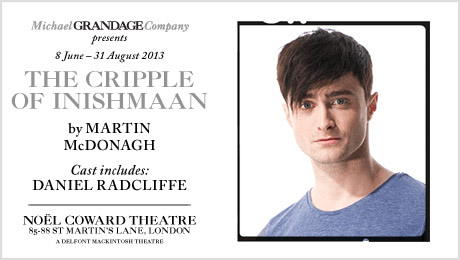 familiar pub - the St George - where we had our first pint before a long stroll past Buckingham Palace and down the Mall into the West End. We had a snack near Covent Garden before heading to the play: The Cripple of Innishman at Noel Coward Theatre. Can't say the play was all that exciting - on the remote island of Innishmore off the west coast of Ireland, a Hollywood film is being made & a young crippled fellow “Cripple Billy” (played by Radcliffe), living on the neighbouring island of Innishman, wants desperately to be in the film just to break away from the bitter tedium of his daily life. But… Oh well it was a night out on the town … and Tana still thinks David Radcliffe can act (though George thinks he was just the name that drew the fans while others in the cast carried the show.)
familiar pub - the St George - where we had our first pint before a long stroll past Buckingham Palace and down the Mall into the West End. We had a snack near Covent Garden before heading to the play: The Cripple of Innishman at Noel Coward Theatre. Can't say the play was all that exciting - on the remote island of Innishmore off the west coast of Ireland, a Hollywood film is being made & a young crippled fellow “Cripple Billy” (played by Radcliffe), living on the neighbouring island of Innishman, wants desperately to be in the film just to break away from the bitter tedium of his daily life. But… Oh well it was a night out on the town … and Tana still thinks David Radcliffe can act (though George thinks he was just the name that drew the fans while others in the cast carried the show.) 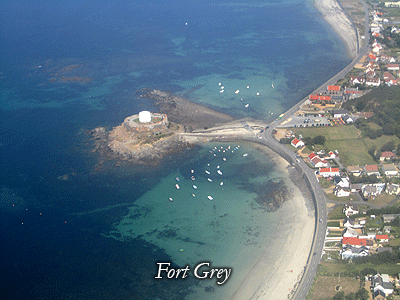 Saint Peter Port (SPP), flying low enough to see Fort Grey, built during the Napoleonic War and
affectionately known as the 'Cup and Saucer' due to its shape.
Saint Peter Port (SPP), flying low enough to see Fort Grey, built during the Napoleonic War and
affectionately known as the 'Cup and Saucer' due to its shape. 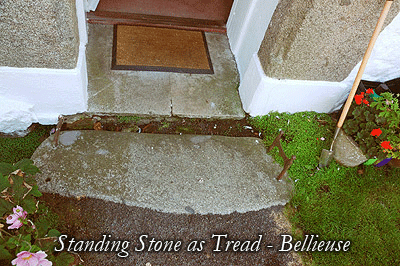 -
- 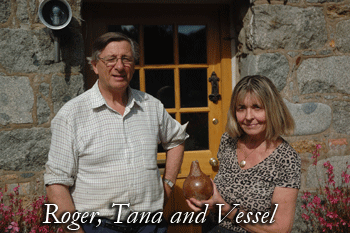 - After telling us about the ancient stones, he brought out an old jug and said: "It's a Belamine jug, produced in the Belgium area around the 1600’s.Originally these jugs were used as wine containers; the face on the neck of this one is a portrait of a Bishop who had a hand in producing this jug. It was found under the front door (at the threshold) of La Bellieuse farm and was positioned there to ward off witches who it was believed could flatten themselves to 1mm and slide under your front door to enter and curse you or put the household or family or livestock under her spell. The process was to put hair and cuttings from the family’s fingernails into a container and then bury it close to the front doorstep (inside) to block a witch’s entry. Roger said that he'd had the contents analyzed and it seems there was nothing but dirt & dust.
- After telling us about the ancient stones, he brought out an old jug and said: "It's a Belamine jug, produced in the Belgium area around the 1600’s.Originally these jugs were used as wine containers; the face on the neck of this one is a portrait of a Bishop who had a hand in producing this jug. It was found under the front door (at the threshold) of La Bellieuse farm and was positioned there to ward off witches who it was believed could flatten themselves to 1mm and slide under your front door to enter and curse you or put the household or family or livestock under her spell. The process was to put hair and cuttings from the family’s fingernails into a container and then bury it close to the front doorstep (inside) to block a witch’s entry. Roger said that he'd had the contents analyzed and it seems there was nothing but dirt & dust. 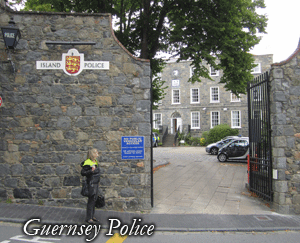 Winding our way back to our hotel, we passed by the Police Station on Hospital Lane. It was of interest to us only because we'd recently started reading a series of murder mysteries by Jill Downie, based in Guernsey in which the main character is a policeman who works out of this station.
Winding our way back to our hotel, we passed by the Police Station on Hospital Lane. It was of interest to us only because we'd recently started reading a series of murder mysteries by Jill Downie, based in Guernsey in which the main character is a policeman who works out of this station.  Checked out of our SPP hotel, we caught the bus to St. Martins where we had booked two nights at a country in called
Checked out of our SPP hotel, we caught the bus to St. Martins where we had booked two nights at a country in called 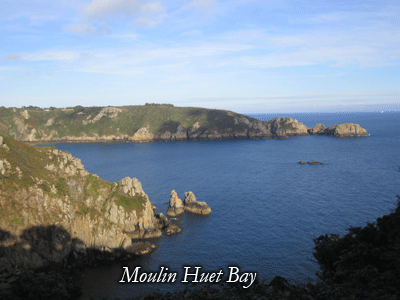 hotel was named "La Barbarie" after Barbary Coast pirates kidnapped and put to ransom the owner of this country house in the 17th century.
hotel was named "La Barbarie" after Barbary Coast pirates kidnapped and put to ransom the owner of this country house in the 17th century.  After breakfast, we wandered into the village of St. Martins and, after browsing through a book sale & chatting with some locals, walked down the Ruette Tranquil (pictured in the borders to this page) to visit Tony at his home (Bellieuse Farm). We had first strolled down that path 4 years ago - it was in September, 2009 when we came upon (as if magically) this old farmhouse and first met Tony and his wife, Judy. They were warm and hospitable and we've stayed in touch. Sadly, Judy died last winter and Tony is now living alone in the house with all of its memories. As he put it: “It’s as if Judy is still here."
After breakfast, we wandered into the village of St. Martins and, after browsing through a book sale & chatting with some locals, walked down the Ruette Tranquil (pictured in the borders to this page) to visit Tony at his home (Bellieuse Farm). We had first strolled down that path 4 years ago - it was in September, 2009 when we came upon (as if magically) this old farmhouse and first met Tony and his wife, Judy. They were warm and hospitable and we've stayed in touch. Sadly, Judy died last winter and Tony is now living alone in the house with all of its memories. As he put it: “It’s as if Judy is still here."  After a pleasant visit with Tony and his two little dogs and catching up on his life and stories of his family - he is a very proud grandfather - we took the bus to Castel to see if we could find WPBL’s grave. Unfortunately, it's a huge churchyard and weather has worn away most of what's written on the old tombstones; so, we didn't manage to locate the grave. (After our return to Canada, we were in touch with the sextant who confirmed the burial information but unfortunately grave locations don’t go back far enough.) However, the cemetery did have one of the
After a pleasant visit with Tony and his two little dogs and catching up on his life and stories of his family - he is a very proud grandfather - we took the bus to Castel to see if we could find WPBL’s grave. Unfortunately, it's a huge churchyard and weather has worn away most of what's written on the old tombstones; so, we didn't manage to locate the grave. (After our return to Canada, we were in touch with the sextant who confirmed the burial information but unfortunately grave locations don’t go back far enough.) However, the cemetery did have one of the 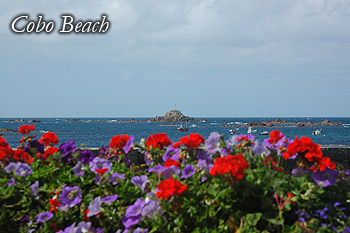 few existing "standing stones" (another, Grandmere, stands at the gate to the church in St Martins) oddly situated in the middle of its Christian graveyard.
few existing "standing stones" (another, Grandmere, stands at the gate to the church in St Martins) oddly situated in the middle of its Christian graveyard.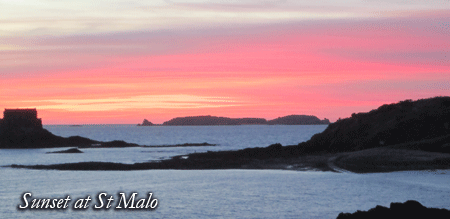
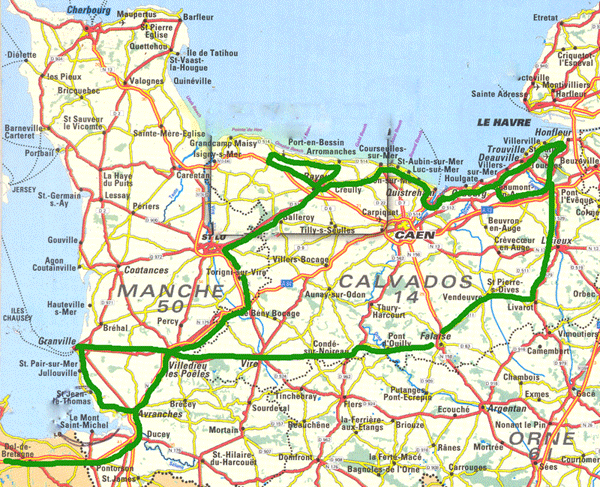
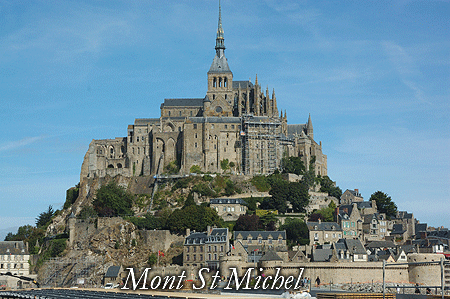 Michel - a craggy rock crowned by a magnificent abbey that appears to erupt from the surrounding landscape of sand or sea depending on the dramatic tides. A pilgrimage site for more than 1,000 years, it exemplifies the society that constructed it with God at the top, the abbey and monastery reaching upward, and below the Great halls and then the town of shops & modest dwellings. If one ignores the modern scene - tour groups, souvenir stands, hotels and restaurants and, especially if one views it from a distance, it's spectacular.
Michel - a craggy rock crowned by a magnificent abbey that appears to erupt from the surrounding landscape of sand or sea depending on the dramatic tides. A pilgrimage site for more than 1,000 years, it exemplifies the society that constructed it with God at the top, the abbey and monastery reaching upward, and below the Great halls and then the town of shops & modest dwellings. If one ignores the modern scene - tour groups, souvenir stands, hotels and restaurants and, especially if one views it from a distance, it's spectacular. 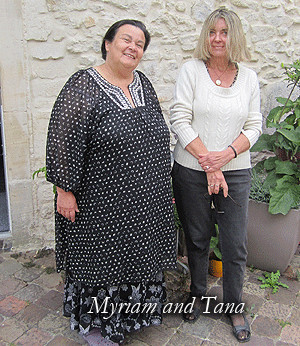

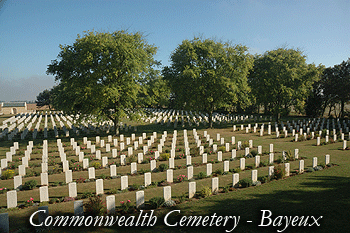 - Bayeau was the first city to be liberated in the Battle of Normandy (and, because the Germans were so focussed on defending Caen) its buildings, including the magnificent Cathedral (which was consecrated at the time of William the Conqueror), were left virtually untouched. We visited the Battle of Normandy Memorial Museum followed by a walk through the British Cemetery - the largest British War cemetery in Normandy, with 4,144 graves (including 338 unidentified and 500 of other nationalities - mostly German.) The adjacent landscaped walk scattered with 26 white tombs on which are engraved the names of more than 2,000 journalists killed throughout the world since 1944, was a sobering introduction to D-Day history.
- Bayeau was the first city to be liberated in the Battle of Normandy (and, because the Germans were so focussed on defending Caen) its buildings, including the magnificent Cathedral (which was consecrated at the time of William the Conqueror), were left virtually untouched. We visited the Battle of Normandy Memorial Museum followed by a walk through the British Cemetery - the largest British War cemetery in Normandy, with 4,144 graves (including 338 unidentified and 500 of other nationalities - mostly German.) The adjacent landscaped walk scattered with 26 white tombs on which are engraved the names of more than 2,000 journalists killed throughout the world since 1944, was a sobering introduction to D-Day history. 
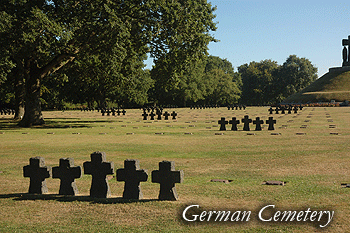 early 20s) had died on both sides of the conflict; a sign at the entrance says "with its melancholy rigour, it is a grave yard for soldiers not all of whom had chosen either the cause or the fight.”
early 20s) had died on both sides of the conflict; a sign at the entrance says "with its melancholy rigour, it is a grave yard for soldiers not all of whom had chosen either the cause or the fight.”
 animals, and were off to our next destination - the working port town of Honfleur. Enroute, we stopped off at Juno Beach (where the Canadians had landed) and took a guided tour of a segment of the beach, entering one of the German bunkers that had been built there by the prisoners of war/slave labour. A walk on the sandy beach, gave us a sense of the how huge the beach was and of the challenge faced all those years ago by the Canadians who landed there. The recently constructed Canadian Juno Beach Centre Centre, the idea for which came from a veteran of that D-Day landing who had noticed that the Canadian story had been left virtually untold, tells (finally) the story of the war effort made by all Canadians, both civilian and military at home and on the various fronts during the Second World War. It's an impressive exhibit and one leaves with a sense that there is good reason to be "proud to be Canadian."
animals, and were off to our next destination - the working port town of Honfleur. Enroute, we stopped off at Juno Beach (where the Canadians had landed) and took a guided tour of a segment of the beach, entering one of the German bunkers that had been built there by the prisoners of war/slave labour. A walk on the sandy beach, gave us a sense of the how huge the beach was and of the challenge faced all those years ago by the Canadians who landed there. The recently constructed Canadian Juno Beach Centre Centre, the idea for which came from a veteran of that D-Day landing who had noticed that the Canadian story had been left virtually untold, tells (finally) the story of the war effort made by all Canadians, both civilian and military at home and on the various fronts during the Second World War. It's an impressive exhibit and one leaves with a sense that there is good reason to be "proud to be Canadian." 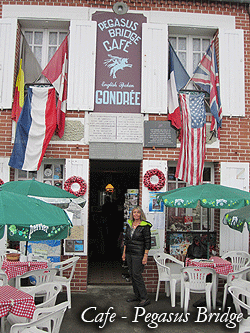 From there it was a short drive to Pegasus Bridge the scene of a remarkable strategic/heroic mission that took place in the opening minutes of the invasion of Normandy. A glider borne unit of the British 6th Airborne Division, commanded by Major John Howard, landed here and, as per orders, took the bridge intact and held it until relief came, playing an important (perhaps crucial) role in limiting the effectiveness of a German counter-attack in the days and weeks following the invasion. A book we had both read (Pegasus Bridge by Stephen E. Ambrose) relays the story in such remarkable detail (acquired through interviews with those who were there) that one gets "a taste" for what happened and a sense of "knowing" what was in the minds (& bodies) of the remarkable people who "pulled it off." After touring the excellent museum and the site where the men landed, we walked across the bridge (now newly constructed) and had lunch at Café Gondrée. It had existed as a cafe at the time of the landing and the owners at that time, Georges & Theresa Gondrée as part of the French Underground, had played a large role, in making that mission a success. Their daughter (Madame Ariette Gondree) who was 4 years old at the time, still runs, and waits tables at, the cafe which is itself a fascinating (very much alive) museum. She is a remarkable lady whose mission in life is to "keep alive the memory." The cafe was the first house to be liberated on D-Day. She's proud of that and of the role her parents played and, to this day, no veteran of that mission is ever asked to pay for a meal.
From there it was a short drive to Pegasus Bridge the scene of a remarkable strategic/heroic mission that took place in the opening minutes of the invasion of Normandy. A glider borne unit of the British 6th Airborne Division, commanded by Major John Howard, landed here and, as per orders, took the bridge intact and held it until relief came, playing an important (perhaps crucial) role in limiting the effectiveness of a German counter-attack in the days and weeks following the invasion. A book we had both read (Pegasus Bridge by Stephen E. Ambrose) relays the story in such remarkable detail (acquired through interviews with those who were there) that one gets "a taste" for what happened and a sense of "knowing" what was in the minds (& bodies) of the remarkable people who "pulled it off." After touring the excellent museum and the site where the men landed, we walked across the bridge (now newly constructed) and had lunch at Café Gondrée. It had existed as a cafe at the time of the landing and the owners at that time, Georges & Theresa Gondrée as part of the French Underground, had played a large role, in making that mission a success. Their daughter (Madame Ariette Gondree) who was 4 years old at the time, still runs, and waits tables at, the cafe which is itself a fascinating (very much alive) museum. She is a remarkable lady whose mission in life is to "keep alive the memory." The cafe was the first house to be liberated on D-Day. She's proud of that and of the role her parents played and, to this day, no veteran of that mission is ever asked to pay for a meal. 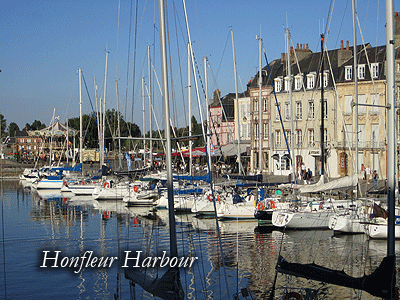 to Honfleur where we checked in to our hotel –
to Honfleur where we checked in to our hotel – 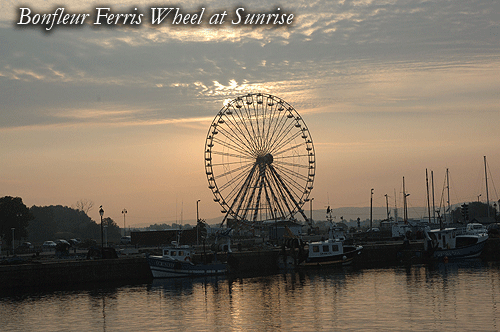
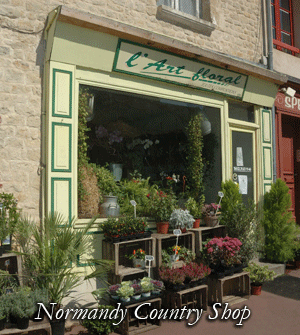
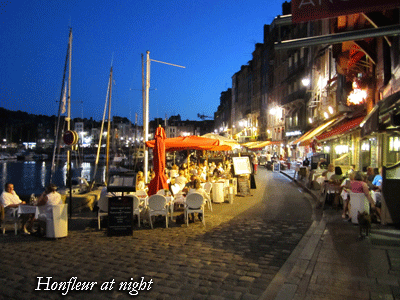 We took a leisurely drive back to Honfleur, stopping to sample some cider, arriving back in Honfleur in time for a final stroll through the lively town and a late dinner - once again at one of the cafes by the Harbour. This time George's seafood platter proved to be breathtakingly spectacular.
We took a leisurely drive back to Honfleur, stopping to sample some cider, arriving back in Honfleur in time for a final stroll through the lively town and a late dinner - once again at one of the cafes by the Harbour. This time George's seafood platter proved to be breathtakingly spectacular.  Set on finding a local restaurant for dinner with steak tartare on the menu, we wandered for several hours when, hungry and discouraged that we'd found nothing, we came across a fabulous, and as we later discovered, famous spot - La Closerie Des Lilas. We dined on the lush terrace where George had his steak tartare, a welcome change after two weeks of seafood.
Set on finding a local restaurant for dinner with steak tartare on the menu, we wandered for several hours when, hungry and discouraged that we'd found nothing, we came across a fabulous, and as we later discovered, famous spot - La Closerie Des Lilas. We dined on the lush terrace where George had his steak tartare, a welcome change after two weeks of seafood. 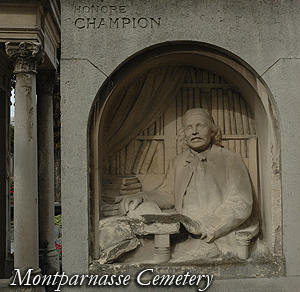 graves of the famous "residents" which were by and large quite plain but because of some of the exquisitely carved monuments (and tributes to soldiers, holocaust victims (& survivors) & Resistance fighters) sprinkled throughout the vast grounds.
graves of the famous "residents" which were by and large quite plain but because of some of the exquisitely carved monuments (and tributes to soldiers, holocaust victims (& survivors) & Resistance fighters) sprinkled throughout the vast grounds.  Then it was on to the Tuileries Garden for a stroll Parisienne-style, bird-feeding and a drink (yes, a beer) at an outdoor cafe in the gardens. Feeling only slightly guilty we skipped Musée d'Orsay because the warmth and sun was just too nice, not something we've experienced often in Paris.
Then it was on to the Tuileries Garden for a stroll Parisienne-style, bird-feeding and a drink (yes, a beer) at an outdoor cafe in the gardens. Feeling only slightly guilty we skipped Musée d'Orsay because the warmth and sun was just too nice, not something we've experienced often in Paris. 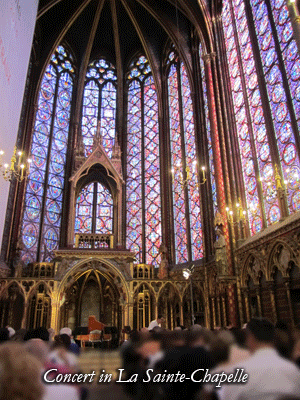 Hungry, we returned to Montparnasse in search of a local restaurant. Here we made our first mistake - an awful restaurant that (luckily for us) kept trying to serve Tana (the vegetarian) a meat lasagna instead of the vegetable tagliatelle she'd order. We finally just paid the bill & walked out (feeling lucky to have escaped eating there) and found a pub with outdoor tables (and great home-made potato chips on the tables) for a simple and tasty croquet monsieur (for George) & something vegetarian for Tana - it's not easy for vegetarians to find food in Paris and, believe it or not, we tend to prefer the beer to the wine.
Hungry, we returned to Montparnasse in search of a local restaurant. Here we made our first mistake - an awful restaurant that (luckily for us) kept trying to serve Tana (the vegetarian) a meat lasagna instead of the vegetable tagliatelle she'd order. We finally just paid the bill & walked out (feeling lucky to have escaped eating there) and found a pub with outdoor tables (and great home-made potato chips on the tables) for a simple and tasty croquet monsieur (for George) & something vegetarian for Tana - it's not easy for vegetarians to find food in Paris and, believe it or not, we tend to prefer the beer to the wine. 